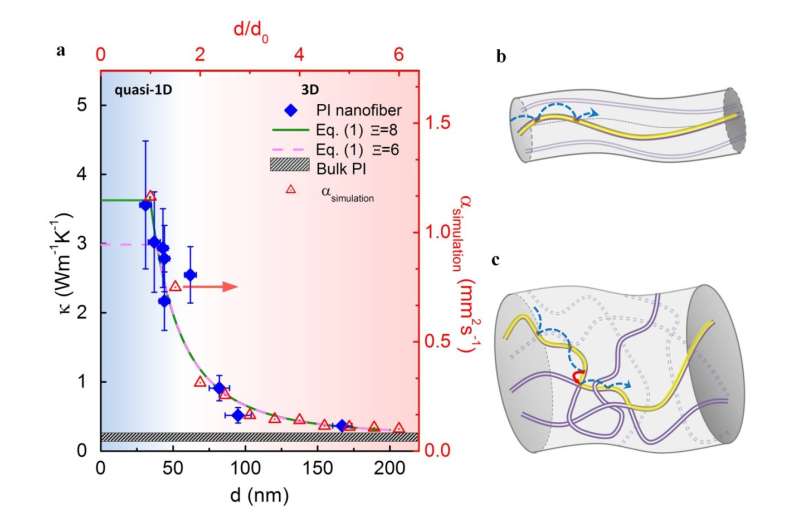'Random walk' of heat carriers in amorphous polymers

The intrinsic structure of amorphous polymers is highly disordered with long, entangled molecular chains. They are usually considered as thermal insulators due to their ultra-low thermal conductivity. One effective way to improve the thermal conductivity of amorphous polymers is modulating the chain conformation by external field, such as stretching force and electric field.
Electrospinning serves as an effective way to control chain conformation. High electric voltage and stretching forces act on the jet during the fiber formation process. Therefore, the molecular chains tend to align along the fiber axis and be less entangled. It has been observed that thinner nanofibers tend to possess higher thermal conductivity, as Figure 1(a) shows. Nanofibers with a diameter larger than 150 nm possess thermal conductivity similar to bulk polymers, while the thermal conductivity of nanofibers with diameter smaller than 50 nm reaches an order of magnitude larger than that of bulk polyimide.
One longstanding problem is how the chain conformation influences thermal conductivity. A recent study published in National Science Review distinguishes the heat transport within the chain and between different chains. Intra-chain heat transport should be more effective than inter-chain heat transport as the intra-chain covalent bond is stronger than inter-chain Van der Walls interactions. If the heat carriers undergo a random walk in the molecular chains, the thermal diffusivity corresponds to different chain conformations.
In ultra-thin polymer nanofibers (Figure 1(b)), all the molecular chains are oriented along the fiber axis. Thus, the heat carriers could only move forward or backward within the molecular chain along the fiber axis, leading to the upper limit of thermal conductivity. Things are totally different in bulk-like polymers (Figure 1(c)): First, the molecular chains are gyrated such that the heat carriers could 'walk' along directions other than the fiber axis; second, heat carriers have chance to 'jump' to another chain at some sites when two chains interact with each other. In other words, heat carriers in bulk polymers undergo many invalid 'steps' for thermal diffusivity along the desired direction. In order to describe the diameter dependence of chain conformation, the new study proposes an empirical function that explains the experimental results well.
Although the real network structure of molecular chains in amorphous polymers is not yet clear, further thermal conductivity models have to incorporate the unique chain structure of polymers and the difference between intra-chain and inter-chain heat transport. The paper concludes that a crossover of heat conduction from 3-D to quasi-1-D has been observed experimentally in amorphous polymer nanofibers obtained from electrospinning. The random walk theory for heat carriers successfully explains the diameter dependence of thermal conductivity.
More information: Lan Dong et al, Dimensional crossover of heat conduction in amorphous Polyimide nanofibers, National Science Review (2018). DOI: 10.1093/nsr/nwy004
Provided by Science China Press



















